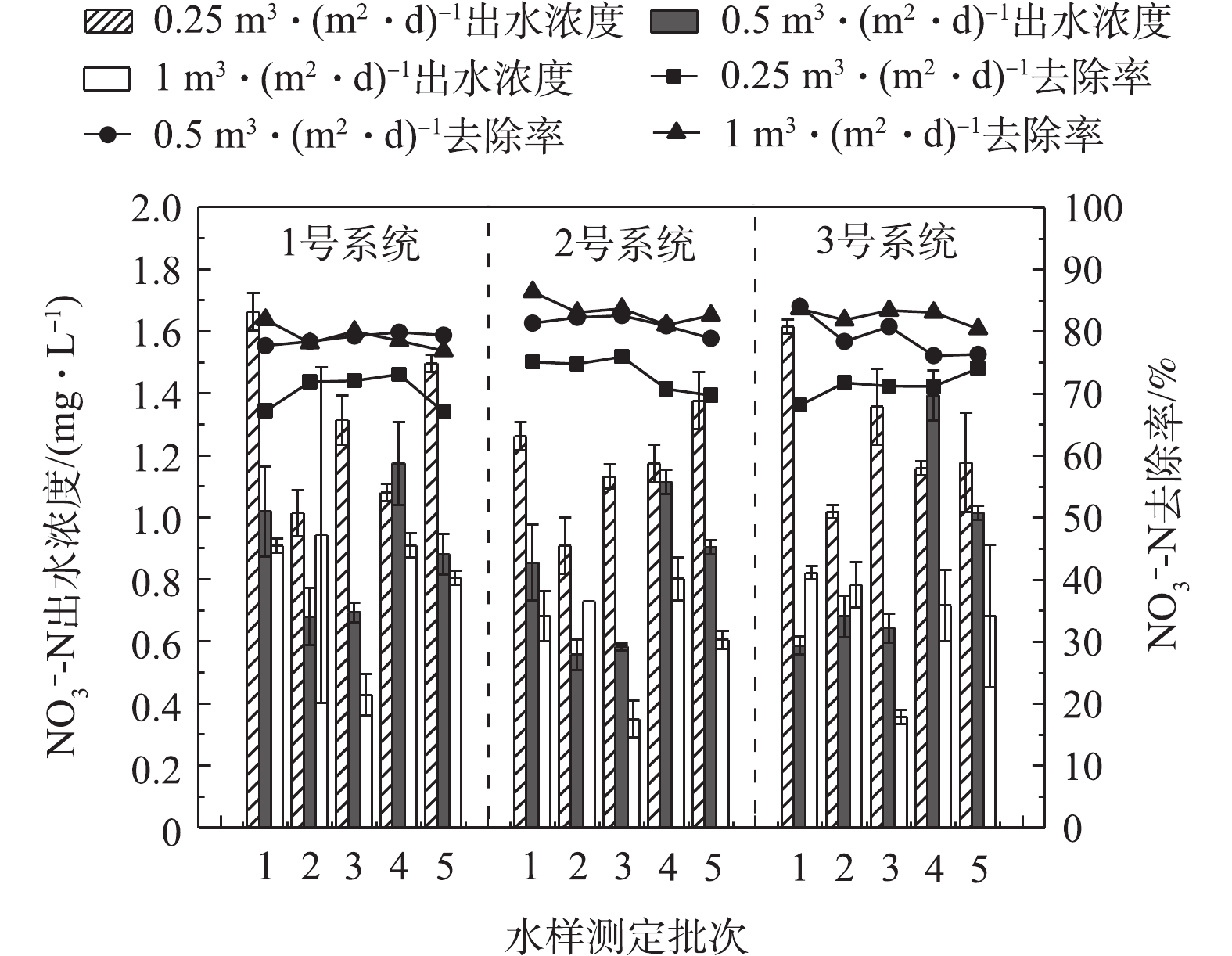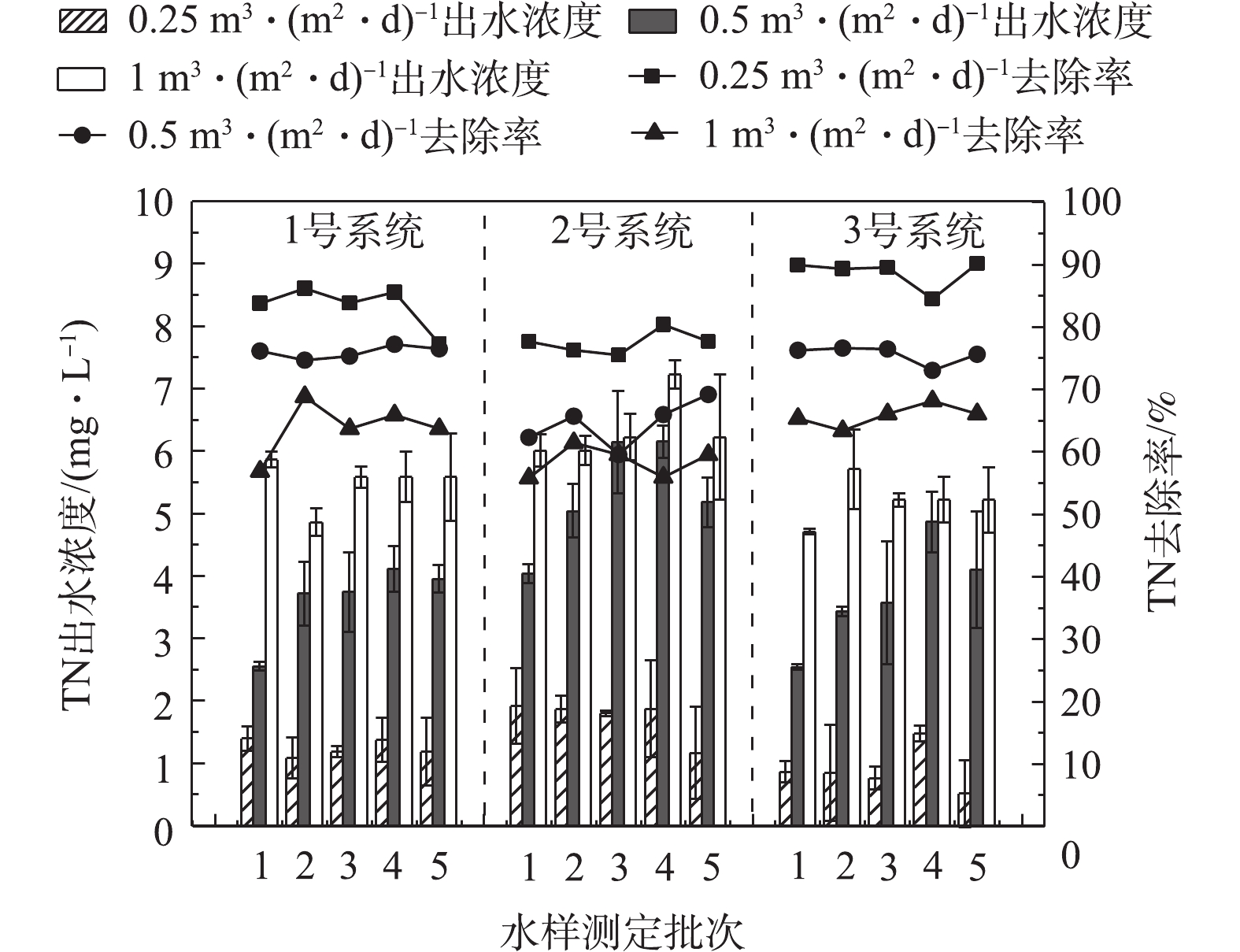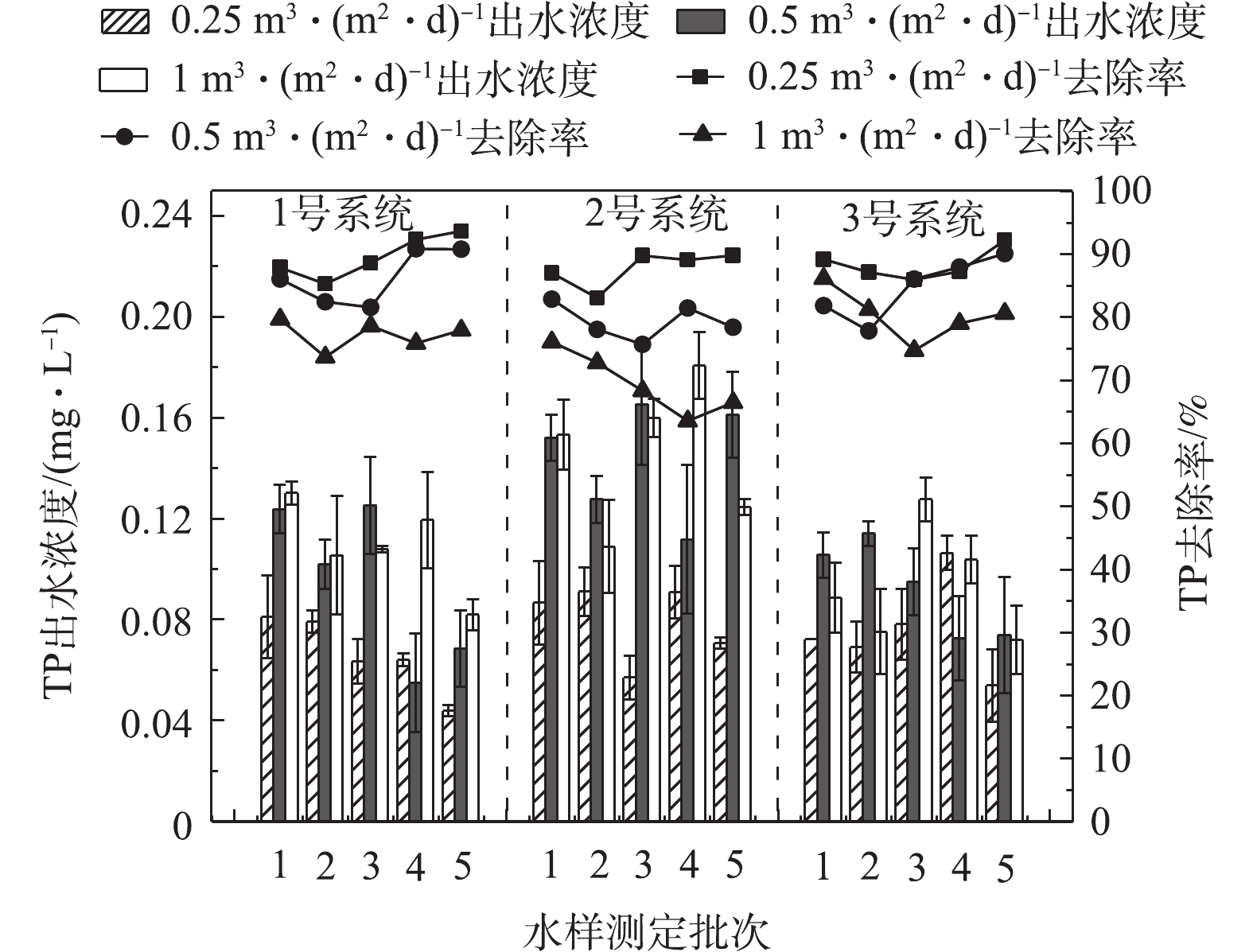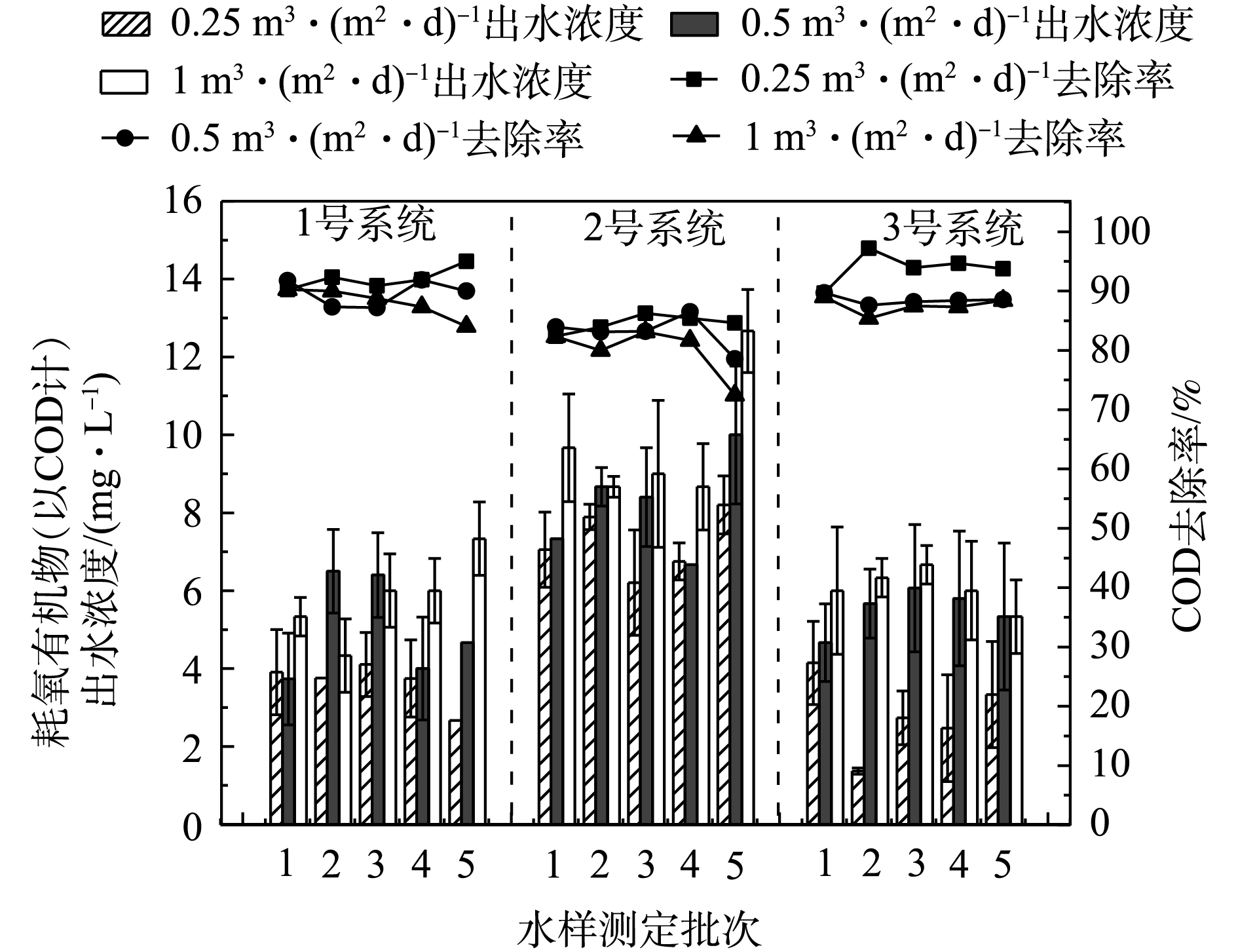-
近年来,关于污水厂尾水处理的研究逐渐受到关注。污水在经过二级生化处理后,虽然污染物能够得到绝大部分的去除,但出水中污染物的浓度仍然远超地表水环境质量标准,直接排放仍会对地表水环境造成一定程度的污染。人工湿地技术由于出水水质稳定,对氮、磷有较高的去除率,管理方便且运行费用小等诸多优势逐渐成为处理污水厂尾水的主要技术之一[1-2]。然而,传统的人工湿地系统在实际应用中存在一些弊端。近年来,对传统人工湿地系统的改良研究逐渐兴起,且在基质改良、微生物强化等方面取得了较大进展[3-4]。在实际运行中,湿地水力负荷的大小严重影响污染物的去除效率,目前关于改良型人工湿地在水力负荷方面的研究较少,对不同的改良型人工湿地系统之间受水力负荷影响的对比研究更是缺乏。以往水力负荷对传统人工湿地去除效率影响的研究成果,对改良型人工湿地应用的适用性尚未得到验证。
水力负荷是影响人工湿地处理效率的重要参数。水力负荷直接影响水力停留时间,进而影响污染物的去除率,包括氨氮(
$ {\rm{NH}}_4^{\rm{ + }}$ -N),硝酸盐($ {\rm{NO}}_3^{\rm{ - }}$ )和耗氧有机物(以COD计)等污染物[5]。有研究[6-7]表明,人工湿地对污染物的去除率会随着水力负荷的增大而降低,然而较低的水力负荷又意味着较低的处理量或较大的湿地处理面积,且不同类型的湿地系统之间受水力负荷的影响程度不同[8-9]。因此,研究不同的改良型人工湿地受水力负荷的影响趋势以及确定湿地运行的最佳水力负荷尤为重要。有研究[10]表明,生物炭和活性炭拥有丰富的孔隙结构,因其巨大的比表面积以及较强的吸附能力,故其表面能够吸附大量的污染物,已被证明是提高污染物去除率的有效材料。而湿地的反硝化能力不足是制约系统脱氮的重要因素。本研究分别使用生物炭、活性炭以及厌氧-异养反硝化菌对人工湿地进行了改良,采用对比实验,搭建了3套规模相同的垂直流人工湿地:1号为生物炭+活性炭改良基质系统;2号为厌氧-异养反硝化菌强化微生物系统;3号为生物炭+活性炭+反硝化菌强化微生物系统。通过改变水力负荷的大小探究了3套垂直流人工湿地系统对模拟污水厂尾水处理效果的影响,确定了3套系统运行的最佳水力负荷,以期为改良型垂直流人工湿地对污水厂尾水的深度处理提供参考。
-
实验用的块石、碎石和中粗砂购自广州某石料厂,块石直径为1 cm左右,碎石直径为0.3~0.5 cm。改良基质按照1∶10的比例,将生物炭与活性炭搅拌混匀,活性炭是圆柱颗粒状;生物炭由粗壮的皇竹草秸秆在缺氧条件下炼制。厌氧-异养反硝化菌从河道底泥中富集培养。系统植物是具有较强分蘖能力且根系发达、密集的皇竹草,采集于华南农业大学农场基地,先将秸秆扦插栽培,在存活后进行种植。
模拟污水厂尾水采用尿素(CON2H4)、磷酸二氢钾(KH2PO4)、硝酸钾(KNO3)、氯化铵(NH4CL)、可溶性淀粉((C6H10O5)n)、奶粉、硫酸镁(MgSO4)以及乙酸钠(CH3COONa)等化学物质,按照《城镇污水处理厂污染物排放标准》(GB 18918-2002)一级B标准配置。污染物进水浓度如表1所示。
-
本研究中的3套垂直流人工湿地搭建于网室之中,装置尺寸为0.7 m×0.7 m×1.2 m。湿地基质填高1 m,出水口高度设置至0.44 m。基质按照粒径大小自下往上填充,首先,在系统底部填充高度为30 cm的块石;然后,在块石上方填充高度为20 cm的碎石,1号和3号湿地首先在碎石上方填充10 cm的改良基质,之后在改良基质上方再填充40 cm的中粗砂,2号系统直接在碎石上方填充50 cm的中粗砂;最后,在每个系统中,均匀种植9棵皇竹草。系统装置如图1所示。
-
2号和3号系统接种厌氧-异养反硝化菌群,系统接种后,封闭3 d开始试运行,7 d后,3套系统正式运行,每日进水8 h,采用间歇式进水。每7 d测定1次水样,监测3套系统进出水中COD、TN、TP、
$ {\rm{NH}}_4^{\rm{ + }}$ -N和$ {\rm{NO}}_3^{\rm{ - }}$ -N等水质指标,3套系统运行期间测试了0.25、0.5和1 m3·(m2·d)−1共3种水力负荷对各污染物的去除效果的影响。 -
水质测定方法:COD采用重铬酸钾消解法;TP采用过硫酸钾消解-钼锑抗分光光度法;TN采用碱性过硫酸钾消解-紫外分光光度法;铵态氮(
$ {\rm{NH}}_4^{\rm{ + }}$ -N)采用纳氏试剂分光光度法;硝态氮($ {\rm{NO}}_3^{\rm{ - }}$ -N)采用酚二磺酸分光光度法。 -
如图2所示,随着水力负荷的改变,3套系统对
$ {\rm{NH}}_4^{\rm{ + }}$ -N具有相同的去除趋势,但去除效果不同。1号湿地系统在水力负荷为0.25、0.5和1 m3·(m2·d)−1的条件下,$ {\rm{NH}}_4^{\rm{ + }}$ -N的平均出水浓度达到了0.59、0.72和0.92 mg·L−1,平均去除率为92.2%、91.8%和85.8%;2号湿地系统在水力负荷为0.25、0.5和1 m3·(m2·d)−1时,$ {\rm{NH}}_4^{\rm{ + }}$ -N的平均出水浓度达到了0.79、0.95和1.07 mg·L−1,平均去除率为89.5%、88.6%和83.4%;3号湿地系统在水力负荷为0.25、0.5和1 m3·(m2·d)−1的条件下,$ {\rm{NH}}_4^{\rm{ + }}$ -N的平均出水浓度分别达到了0.56、0.62和0.90 mg·L−1,平均去除率达到了92.8%、92.4%和85.9%。3套系统在水力负荷为0.25 m3·(m2·d)−1和0.5 m3·(m2·d)−1时,对
$ {\rm{NH}}_4^{\rm{ + }}$ -N均有较高的去除率,且差别不明显,这说明在水力负荷为0.5 m3·(m2·d)−1时,系统未超出系统负载。当水力负荷增加到1 m3·(m2·d)−1时,$ {\rm{NH}}_4^{\rm{ + }}$ -N的去除率明显下降。有研究[11-13]表明,硝化反应是湿地系统去除$ {\rm{NH}}_4^{\rm{ + }}$ -N的主要方式,当水力负荷增大时,污水滞留会造成系统内部溶解氧浓度降低,从而抑制系统中硝化细菌的生长,导致硝化能力降低。此外,水力负荷增大,会使水力停留时间缩短,使$ {\rm{NH}}_4^{\rm{ + }}$ -N未反应完全就被排出湿地。上述2种原因均会导致系统对$ {\rm{NH}}_4^{\rm{ + }}$ -N的去除效果变差。当水力负荷为0.25 m3·(m2·d)−1时,3号系统对$ {\rm{NH}}_4^{\rm{ + }}$ -N的去除率分别比1号系统和2号系统高出0.63%和3.37%;当水力负荷增大到1 m3·(m2·d)−1时,3号系统对$ {\rm{NH}}_4^{\rm{ + }}$ -N的去除率分别比1号系统和2号系统高出0.12%和2.57%。通过系统间的实验结果对比表明,生物炭、活性炭以及厌氧-异养反硝化微生物提高了3号系统对$ {\rm{NH}}_4^{\rm{ + }}$ -N的去除效果,但随着水力负荷的增大,提高效率有所下降。这说明在低水力负荷时添加生物炭、活性炭以及厌氧-异养反硝化菌具有更好的改良效果。 -
3套系统对污水中
$ {\rm{NO}}_3^{\rm{ - }}$ -N的去除效果受水力负荷的影响如图3所示。1号湿地系统在水力负荷为0.25、0.5和1 m3·(m2·d)−1的条件下,$ {\rm{NO}}_3^{\rm{ - }}$ -N的平均出水浓度达到了1.31、0.89和0.80 mg·L−1,平均去除率为70.3%、79.0%和79.1%。2号湿地系统在水力负荷为0.25、0.5和1 m3·(m2·d)−1的条件下,$ {\rm{NO}}_3^{\rm{ - }}$ -N的平均出水浓度达到了1.17、0.80和0.63 mg·L−1,平均去除率为73.3%、81.2%和83.4%。3号湿地系统在水力负荷为0.25、0.5和1 m3·(m2·d)−1的条件下,$ {\rm{NO}}_3^{\rm{ - }}$ -N的平均出水浓度达到了1.27、0.86和0.67 mg·L−1,平均去除率为71.3%、79.2%和82.5%。3套系统在水力负荷为1 m3·(m2·d)−1时对
$ {\rm{NO}}_3^{\rm{ - }}$ -N的去除率均高于0.25 m3·(m2·d)−1和0.5 m3·(m2·d)−1的去除率。有研究[14]证明,湿地系统对$ {\rm{NO}}_3^{\rm{ - }}$ -N的去除主要通过厌氧条件下微生物的反硝化反应进行,当水力负荷较低时,湿地内有较强的富氧能力,导致污水中溶解氧浓度较高,会抑制反硝化反应的进行,同时由于低水力负荷条件下系统的硝化能力较强,从而导致$ {\rm{NO}}_3^{\rm{ - }}$ -N的积累,造成湿地对$ {\rm{NO}}_3^{\rm{ - }}$ -N的去除率较低。水力负荷从0.5 m3·(m2·d)−1增大到1 m3·(m2·d)−1时,$ {\rm{NO}}_3^{\rm{ - }}$ -N的去除率变化较小,水力负荷增大虽然使系统内部有更好的厌氧环境,更利于反硝化反应的进行,但由于系统水力负荷过高导致水力停留时间的缩短,微生物与污染物未完全接触就被排出系统,从而使系统对$ {\rm{NO}}_3^{\rm{ - }}$ -N的去除效果变化不明显[15-16];当水力负荷从0.25 m3·(m2·d)−1增加到1 m3·(m2·d)−1时,3号系统对$ {\rm{NO}}_3^{\rm{ - }}$ -N的去除率比1号系统分别提高了1.00%和3.38%,这证明向系统中接种厌氧-异养反硝化微生物能够提高系统对$ {\rm{NO}}_3^{\rm{ - }}$ -N的去除效果,并且当水力负荷提高时增益效果更明显。3号系统对$ {\rm{NO}}_3^{\rm{ - }}$ -N的去除率始终低于2号系统。有研究[17]表明,反硝化反应需要碳源提供电子,而3号系统对有机污染物的去除率高于2号系统,导致反硝化反应过程中碳源不足,造成对$ {\rm{NO}}_3^{\rm{ - }}$ -N的去除效果降低。当水力负荷从0.25 m3·(m2·d)−1增加到1 m3·(m2·d)−1时,2号系统对$ {\rm{NO}}_3^{\rm{ - }}$ -N的去除率比3号系统分别提高了2.00%和0.89%,这证明当有机质降解效果下降后,未降解的有机质参与到反硝化过程中使3号系统对$ {\rm{NO}}_3^{\rm{ - }}$ -N的去除效果提高。 -
随着水力负荷的改变,3套系统对污水中TN的去除趋势如图4所示。1号湿地系统在水力负荷为0.25、0.5和1 m3·(m2·d)−1的条件下,TN的平均出水浓度达到了1.25、3.61和5.49 mg·L−1,平均去除率为83.4%、76.0%和63.8%。2号湿地系统在水力负荷为0.25、0.5和1 m3·(m2·d)−1的条件下,TN的平均出水浓度分别达到了1.72、5.31和6.34 mg·L−1,平均去除率为77.5%、64.6%和58.5%。3号湿地系统在水力负荷为0.25、0.5和1 m3·(m2·d)−1的条件下,TN的平均出水浓度分别达到了0.89、3.70和5.21 mg·L−1,平均去除率为88.7%、75.6%和65.8%。
3套系统对TN的去除率在水力负荷为0.25 m3·(m2·d)−1时最高,且明显高于0.5 m3·(m2·d)−1和1 m3·(m2·d)−1。有研究[18-20]指出,人工湿地通过基质吸附、沉淀,植物吸收和微生物降解等共同作用去除污水中的氮素,其中,微生物脱氮占人工湿地系统的50%~80%,且其和水力负荷成反比,水力负荷较低时更有利于系统的脱氮。当水力负荷从0.25 m3·(m2·d)−1增加到1 m3·(m2·d)−1时,3套系统对TN的去除率分别降低了19.53%、19.05%和22.88%,湿地系统对TN的去除效果受水力负荷的影响较大。这主要是由于微生物脱氮受水中DO和水力停留时间的影响较大,水力负荷增大时,会降低水中DO浓度,缩短水力停留时间,影响微生物的脱氮能力,导致TN的去除率降低;当水力负荷为0.25 m3·(m2·d)−1时,3号系统对TN的去除率分别比1号系统和2号系统高出5.36%和11.18%。当水力负荷增大到1 m3·(m2·d)−1时,3号系统对TN的去除率分别比1号系统和2号系统高出2.00%和7.35%。由以上研究结果可知,生物炭、活性炭以及厌氧-异养反硝化微生物提高了3号系统对TN的去除效果,但随着水力负荷的增大,提高效率有所下降,证明在低水力负荷时添加生物炭、活性炭以及厌氧-异养反硝化菌,对湿地去除TN具有更好的改良效果。
-
如图5所示,随着水力负荷的改变,3套系统对污水中TP的去除趋势相同。1号湿地系统在水力负荷为0.25、0.5和1 m3·(m2·d)−1的条件下,TP的平均出水浓度分别达到了0.07、0.09和0.11 mg·L−1,平均去除率为89.6%、86.4%和77.2%。2号湿地系统在水力负荷为0.25、0.5和1 m3·(m2·d)−1的条件下,TP的平均出水浓度分别达到了0.08、0.14和0.15 mg·L−1,平均去除率为87.8%、79.3%和69.5%。3号湿地系统在水力负荷为0.25、0.5和1 m3·(m2·d)−1的条件下,TP的平均出水浓度分别达到了0.08、0.09和0.09 mg·L−1,平均去除率达到了88.4%、84.8%和80.4%。
3套系统对污水中TP的去除率在低水力负荷时较高,随着水力负荷的增加去除率慢慢降低。人工湿地对污水中磷元素的去除主要通过3种方式:基质吸附、植物吸收和微生物同化。有研究[21-23]指出,水中溶解氧直接与微生物作用相关,决定湿地内氧化还原条件,好氧条件下聚磷菌吸收系统内的磷,厌氧条件聚磷菌会释放吸收的过量磷,而水力负荷的改变,会影响系统内部的溶解氧浓度,直接影响微生物除磷。当水力负荷从0.25 m3·(m2·d)−1增加到1 m3·(m2·d)−1时,3号系统对TP的去除率比2号系统分别提高了0.60%和10.9%,这证明生物炭和活性炭基质能够提高系统对TP的去除效果,并且当水力负荷提高时增益效果更明显,证明生物炭和活性炭基质在高水力负荷时对湿地去除TP拥有更好的改良效果。1号系统和3号系统在3种水利负荷条件下,对TP的去除效果区别不明显,这说明厌氧-异养反硝化菌对系统去除TP的影响较弱。
-
如图6所示,随着水力负荷的改变,3套系统对污水中COD的去除趋势相同。1号湿地系统在水力负荷为0.25、0.5和1 m3·(m2·d)−1的条件下,出水中COD值达到了3.64、5.06和5.80 mg·L−1,COD平均去除率达到了92.1%、89.6%和88.1%。2号湿地系统在水力负荷为0.25、0.5和1 m3·(m2·d)−1的条件下,出水中COD值分别达到了7.22、8.21和9.73 mg·L−1,COD平均去除率达到了84.5%、83.1%和79.9%。3号湿地系统在水力负荷为0.25、0.5和1 m3·(m2·d)−1的条件下,出水中COD值分别达到了2.81、5.51和6.07 mg·L−1,COD平均去除率达到了93.8%、88.5%和87.5%。
3套系统对污水中COD的去除率均在水力负荷为0.25 m3·(m2·d)−1时最高,随着水力负荷的增加,对COD的去除率开始下降,但下降不明显。人工湿地对耗氧有机污染物的去除主要通过基质吸附和生物膜的作用,且好氧微生物起到了关键性作用,水力负荷较低时,水中溶解氧含量较高,能够为好氧微生物的反应创造有利条件,更有利于耗氧有机污染物的降解[24-26];当水力负荷从0.25 m3·(m2·d)−1增加到1 m3·(m2·d)−1时,3号系统对COD的去除率比2号系统分别提高了9.32%和7.61%,这说明生物炭和活性炭基质能够提高系统对COD的去除效果。但随着水力负荷的提高,生物炭和活性炭基质对COD去除率的提高效果减弱,这证明在低水力负荷时添加生物炭和活性炭基质对湿地去除COD有更好的改良效果。1号系统和3号系统在3种水利负荷条件下,对COD的去除效果区别不明显,这说明厌氧-异养反硝化菌对系统去除COD的影响较小。
-
1) 3套系统对污水中
$ {\rm{NH}}_4^{\rm{ + }}$ -N的去除率随着水力负荷的增大逐渐降低,且在水力负荷从0.5 m3·(m2·d)−1增大至1 m3·(m2·d)−1时,去除率下降明显;对$ {\rm{NO}}_3^{\rm{ - }}$ -N的去除率随着水力负荷的增大逐渐升高,水力负荷从0.5 m3·(m2·d)−1增大到1 m3·(m2·d)−1时,去除率增幅下降,但明显高于0.25 m3·(m2·d)−1时的去除率;3套系统对TN的去除率在0.25 m3·(m2·d)−1时最高,随着水力负荷的增大逐渐降低,且下降幅度较大;对TP的去除率在水力负荷为0.25 m3·(m2·d)−1时最高,且随着水力负荷的增加而降低;对COD的去除率在水力负荷为0.25 m3·(m2·d)−1时最高,但受水力负荷的影响变化不明显。污水厂尾水对地表水环境造成污染的主要因素是氮磷污染物的超标,综合3套改良湿地对氮磷元素的整体去除效果以及考虑到湿地处理污水的总负荷,建议运行水力负荷为0.5 m3·(m2·d)−1。2)生物炭和活性炭改良基质,能够提高湿地系统对
$ {\rm{NH}}_4^{\rm{ + }}$ -N、TN、TP和COD的去除效果,且在低水力负荷条件下对污水中的$ {\rm{NH}}_4^{\rm{ + }}$ -N、TN和COD拥有更好的去除效果,其随着水力负荷的增大,改良效果逐渐减弱,而对污水中TP去除效果的改良则在高水力负荷时优于低水力负荷。厌氧-异养反硝化菌能够稳定提高湿地系统对$ {\rm{NH}}_4^{\rm{ + }}$ -N、$ {\rm{NO}}_3^{\rm{ - }}$ -N和TN的去除效果,效果不显著可能是菌种投加量不足,未连续投加以及碳源不足等原因,还值得深入探究。但实验结果表明,在高水力负荷时对$ {\rm{NO}}_3^{\rm{ - }}$ -N的去除效果优于低水力负荷,而在低水力负荷时对$ {\rm{NH}}_4^{\rm{ + }}$ -N和TN具有更好的去除效果。
水力负荷对改良型垂直流人工湿地降解模拟污水厂尾水效果的影响
Effect of hydraulic loading on the degradation of the simulated tail water from wastewater treatment plant by improved vertical flow constructed wetland
-
摘要: 为确定改良型垂直流人工湿地降解模拟污水厂尾水的最佳水力负荷,采用生物炭和活性炭改良、微生物强化以及同时添加生物炭、活性炭和微生物改良强化的3套垂直流人工湿地系统,研究了其在3种水力负荷条件下(0.25、0.5和1 m3·(m2·d)−1),对模拟污水厂尾水中污染物的去除效果。结果表明,3套垂直流人工湿地系统均在低水力负荷(0.25 m3·(m2·d)−1)时对模拟污水厂尾水中
$ {{\rm{NH}}_4^ + }$ -N、TN、TP和COD的去除率较高,但随着水力负荷的增大其去除率逐渐降低。3套垂直流人工湿地系统对$ {{\rm{NO}}_3^{\rm{ - }}}$ -N的去除率均在高水力负荷(1 m3·(m2·d)−1)时较高,且随着水力负荷的变大,其去除率逐渐升高,但去除率的增长幅度变缓;实验证明,生物炭和活性炭改良基质能够提高湿地系统对$ { {\rm{NH}}_4^ + }$ -N、TN、TP和COD的去除效果,并且在低水力负荷时对$ {{\rm{NH}}_4^ +} $ -N、TN和COD的去除拥有更好的改良效果,而对TP去除的改良则在高水力负荷时优于在低水力负荷时。厌氧-异养反硝化菌能够提高湿地系统对$ {{\rm{NH}}_4^ + }$ -N、$ {{\rm{NO}}_3^{\rm{ - }}}$ -N和TN的去除效果,并且在高水力负荷时对$ { {\rm{NO}}_3^{\rm{ - }}}$ -N的改良效果优于低水力负荷,而在低水力负荷时对$ { {\rm{NH}}_4^ +} $ -N和TN具有更好的改良效果。综合考虑多种污染物的去除效果,确定3套改良型垂直流人工湿地系统的最佳水力负荷为0.5 m3·(m2·d)−1。-
关键词:
- 改良型垂直流人工湿地 /
- 水力负荷 /
- 生物炭 /
- 异养反硝化菌
Abstract: To study the optimal hydraulic loading of improved vertical flow constructed wetland (VFCW) degrading the simulated tail water in wastewater treatment plant, three improved VFCW systems were built with addition of biochar-activated carbon, microorganisms or biochar-activated carbon-microorganisms, respectively. The effects of different hydraulic loading conditions (0.25, 0.5 and 1 m3·(m2·d)−1) on the pollutants removal from the simulated tail water in wastewater treatment plant were investigated. Results showed that the three improved VFCW systems had high removal rates of$ {\rm{NH}}_4^ + $ -N, TN, TP, and COD in the tail water of simulated sewage plant at a low hydraulic loading of 0.25 m3·(m2·d)−1, and the removal rates progressively decreased with the increase of hydraulic loading. The removal rate of$ {\rm{NO}}_3^{\rm{ - }}$ -N by these three improved VFCW systems was higher at the hydraulic loading of 1 m3·(m2·d)−1, and the removal rate increased with the increase of the hydraulic loading, while the increment of removal rate slowed down gradually. The experiment results showed that biochar-activated carbon modification could improve the removal efficiencies of$ {\rm{NH}}_4^ + $ -N, TN, TP and COD in VFCW systems, even had a better removal effects for$ {\rm{NH}}_4^ + $ -N, TN and COD at low hydraulic loadings, while higher TP removal occurred at higher hydraulic loadings. The presence of anaerobic-heterotrophic denitrifying bacteria could improve the removal effect of$ {\rm{NH}}_4^ + $ -N,$ {\rm{NO}}_3^{\rm{ - }}$ -N and TN in VFCW system, and better improvements were achieved for$ {\rm{NO}}_3^{\rm{ - }}$ -N removal occurred at higher hydraulic loadings, while for$ {\rm{NH}}_4^ + $ -N and TN removal at lower hydraulic loadings. Comprehensive consideration of the simultaneous removal of various pollutants, 0.5 m3·(m2·d)−1 was recommended as the optimal hydraulic loading for the three improved VFCW systems. -

-
表 1 模拟污水厂尾水中各污染物的浓度
Table 1. Concentration of pollutants in simulated tail water
mg·L−1 检测结果 浓度范围 平均值 COD 40.07~54.67 47.94±3.95 $ {\rm{NH}}_4^{\rm{ + }}$ -N
5.64~10.30 7.46±1.29 $ {\rm{NO}}_3^{\rm{ - }}$ -N
2.15~5.84 4.13±0.89 TN 8.2~16.83 12.77±3.94 TP 0.37~0.89 0.61±0.14 -
[1] 凌祯, 杨具瑞, 于国荣, 等. 不同植物与水力负荷对人工湿地脱氮除磷的影响[J]. 中国环境科学, 2011, 31(11): 1815-1820. [2] ÜLO M, DOTRO G, EBIE Y, et al. Greenhouse gas emission in constructed wetlands for wastewater treatment: A review[J]. Ecological Engineering, 2014, 66(3): 19-35. [3] DE ROZARI P, GREENWAY M, ELHANANDEH A. Phosphorus removal from secondary sewage and septage using sand media amended with biochar in constructed wetland mesocosms[J]. Science of the Total Environment, 2016, 569-570: 123-133. doi: 10.1016/j.scitotenv.2016.06.096 [4] KASAK K, TRUU J, OSTONEN I, et al. Biochar enhances plant growth and nutrient removal in horizontal subsurface flow constructed wetlands[J]. Science of the Total Environment, 2018, 639: 67-74. doi: 10.1016/j.scitotenv.2018.05.146 [5] GHOSH D, GOPAL B. Effect of hydraulic retention time on the treatment of secondary effluent in a subsurface flow constructed wetland[J]. Ecological Engineering, 2010, 36(8): 1044-1051. doi: 10.1016/j.ecoleng.2010.04.017 [6] SINDILARIU P D, BRINKER A, REITER R. Factors influencing the efficiency of constructed wetlands used for the treatment of intensive trout farm effluent[J]. Ecological Engineering, 2009, 35(5): 711-722. doi: 10.1016/j.ecoleng.2008.11.007 [7] 李紫霞, 唐晓丹, 崔理华. 3种负荷对模拟垂直流人工湿地去除氮、磷效果的影响[J]. 环境工程学报, 2016, 10(2): 637-642. doi: 10.12030/j.cjee.20160220 [8] PROCHASKA C A, ZOUBOULIS A I, ESKRIDGE K M. Performance of pilot-scale vertical-flow constructed wetlands, as affected by season, substrate, hydraulic load and frequency of application of simulated urban sewage[J]. Ecological Engineering, 2007, 31(1): 57-66. doi: 10.1016/j.ecoleng.2007.05.007 [9] PANUVATVANICH A, KOOTTATEP T, KONE D. Hydraulic behaviour of vertical-flow constructed wetland under different operating conditions[J]. Environmental Technology, 2009, 30(10): 1031-1040. doi: 10.1080/09593330903051667 [10] CHAN K Y, VAN ZWIETEN L, MESZAROS I, et al. Agronomic values of greenwaste biochar as a soil amendment[J]. Australian Journal of Soil Research, 2007, 45(8): 629. doi: 10.1071/SR07109 [11] 张世羊, 常军军, 高毛林, 等. 曝气对垂直流湿地处理水产养殖废水脱氮的影响[J]. 农业工程学报, 2015, 31(9): 235-241. doi: 10.11975/j.issn.1002-6819.2015.09.036 [12] 梁奇奇, 沈耀良, 吴鹏, 等. 植物种类与水力负荷对人工湿地去除污染物的交互作用[J]. 环境工程学报, 2016, 10(6): 2975-2980. doi: 10.12030/j.cjee.201501132 [13] MOLLE P, LIENARD A, GRASMICK A, et al. Effect of reeds and feeding operations on hydraulic behaviour of vertical flow constructed wetlands under hydraulic overloads[J]. Water Research, 2006, 40(3): 606-612. doi: 10.1016/j.watres.2005.11.026 [14] ROUSSEAU D P, VANROLLEGHEM P A, DE P N. Model-based design of horizontal subsurface flow constructed treatment wetlands: A review[J]. Water Research, 2004, 38(6): 1484-1493. doi: 10.1016/j.watres.2003.12.013 [15] 黄杉, 怀静, 吴娟, 等. 碳源补充促进人工湿地脱氮研究进展[J]. 水处理技术, 2018, 44(1): 13-16. [16] LIN Y F, JING S R, LEE D Y, et al. Nitrate removal from groundwater using constructed wetlands under various hydraulic loading rates[J]. Bioresource Technology, 2008, 99(16): 7504-7513. doi: 10.1016/j.biortech.2008.02.017 [17] ZHANG C, YIN Q, WEN Y, et al. Enhanced nitrate removal in self-supplying carbon source constructed wetlands treating secondary effluent: The roles of plants and plant fermentation broth[J]. Ecological Engineering, 2016, 91: 310-316. doi: 10.1016/j.ecoleng.2016.02.039 [18] 余志敏, 袁晓燕, 刘胜利, 等. 水力条件对复合人工湿地处理城市受污染河水效果的影响[J]. 环境工程学报, 2011, 5(4): 757-762. [19] LI F, LU L, ZHENG X, et al. Enhanced nitrogen removal in constructed wetlands: Effects of dissolved oxygen and step-feeding[J]. Bioresource Technology, 2014, 169(5): 395-402. [20] CHANG J J, WU S Q, DAI Y R, et al. Nitrogen removal from nitrate-laden wastewater by integrated vertical-flow constructed wetland systems[J]. Ecological Engineering, 2013, 58(10): 192-201. [21] 梁康, 常军军, 王飞华, 等. 垂直流人工湿地对尾水的净化效果及最佳水力负荷[J]. 湖泊科学, 2016, 28(1): 114-123. doi: 10.18307/2016.0113 [22] BOJCEVSKA H, TONDERSKI K. Impact of loads, season and plant species on the performance of a tropical constructed wetland polishing effluent from sugar factory stabilization ponds[J]. Ecological Engineering, 2007, 29(1): 66-76. doi: 10.1016/j.ecoleng.2006.07.015 [23] YU S, SUN P, ZHENG W, et al. The effect of COD loading on the granule-based enhanced biological phosphorus removal system and the recoverability[J]. Bioresource Technology, 2014, 171(1): 80-87. [24] 张荣新, 焦玉恩, 傅金祥, 等. 不同水力负荷率对潜流人工湿地内部污染物迁移转化的影响[J]. 环境污染与防治, 2018, 40(7): 748-754. [25] 李丽, 王全金. 人工湿地-稳定塘组合系统对污染物的去除效果[J]. 工业水处理, 2016, 36(7): 22-25. doi: 10.11894/1005-829x.2016.36(7).022 [26] AVILA C, MATAMOROS V, REYESCONTRERAS C, et al. Attenuation of emerging organic contaminants in a hybrid constructed wetland system under different hydraulic loading rates and their associated toxicological effects in wastewater[J]. Science of the Total Environment, 2014, 470-471(2): 1272-1280. -



















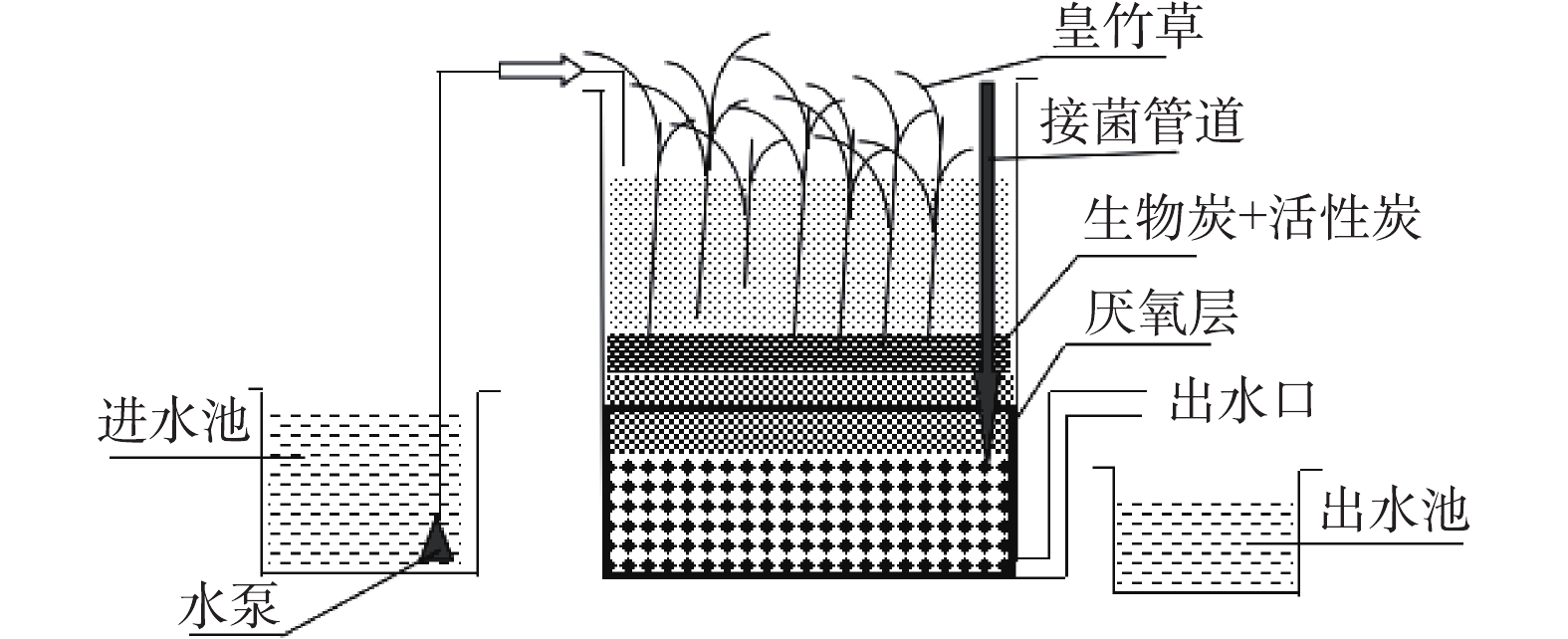
 下载:
下载:

